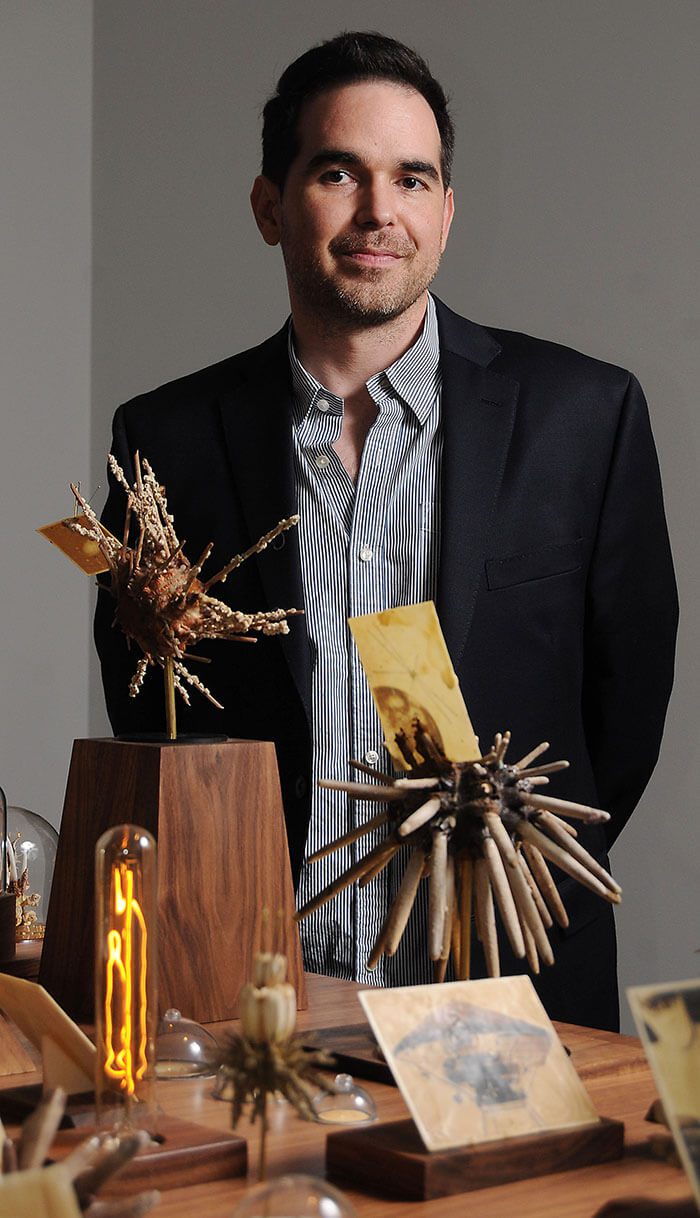
Houston-based artist Dario Robleto was recently described by Krista Tippett of onbeing.org as “famous for spinning and shaping unconventional materials—from dinosaur fossils to pulverized vintage records, from swamp root to cramp bark. He joins words and objects in a way that distills meaning at once social, poetic, and scientific.” His art projects bleed fact and fiction, science and art, truth and myth.
Robleto’s work, interests, and medium span far beyond the traditional boundaries of art and art making, as evidenced by his recent participation as a panelist for complexity science research center Santa Fe Institute’s InterPlanetary Project in partnership with Creative Santa Fe. Science fiction authors, scientists, filmmakers, and artists came together for this event to discuss the political, scientific, environmental, and ethical ramifications of what it means to become an InterPlanetary civilization.
As a panelist, Dario discussed his position as Artist in Residence at the SETI Institute, an organization dedicated to searching for extraterrestrial life. He also recently served as the artistic consultant to Breakthrough Message, a multi-national effort that aims to encourage intellectual and technical debate about how and what to communicate if the current search for intelligent beings beyond Earth is successful. I wanted to learn more about Dario’s role at SETI; his perspective on how the arts can shape (or reshape) our worldview; and, of course, his thoughts on the ramifications for our civilization if we ever do make contact.
1
As an artist-in-residence at the SETI Institute and as artistic consultant to the Breakthrough Message team, you have spent much time contemplating the problem of universal message design as it relates to possible contact with other intelligent life in the Universe. Why do you feel it is important that artists be represented on these teams?
Historically, the problems SETI and Breakthrough pursue have been problems of the natural sciences and mathematics that engage astronomers, astrophysicists, astrobiologists, encoding and transmission experts, and more. But because of the complex nature of the problem, the field must embrace a wider knowledge base if it is to move forward. More recently, we have seen the social sciences, through disciplines such as linguistics, anthropology, archeology, psychology, and sociology, contribute meaningful dialogue to the field. But for various reasons, the arts have lagged behind when being invited into this discussion.
This has always struck me as odd because art’s ability to create aesthetic experience—the vehicle for communicating complex intellectual/emotional states of one’s existence—is crucial to understanding one of the most profound questions we can ask: are we alone? To ponder the nature of aloneness and the deep need to satiate the longing it inspires—either at the level of an individual human life, or at the planetary scale of an entire species unsure if it will ever know companionship across the cosmos—is a problem the arts have much knowledge to contribute to.
While I firmly believe the arts can enrich, even lead the way, on some very practical levels of interstellar message design and detection—how one encodes altruism in various forms, for example—there is important work to be done in communicating to our own species why it continues to be crucial we think of ourselves within a larger cosmological scope. The palpable sense of fresh energy from Breakthrough, and NASA and SETI’s innovation in detection approaches, make it clear to me we are likely on the threshold of finally answering if there is life elsewhere in the Universe. In fact, in 2015 at a congressional panel, the chief scientist at NASA made an announcement, which included a timeline (a few decades) to the discovery of the existence of life beyond our planet. This public statement of timelines on such a sensitive topic by someone of her rank is generally unheard of in her field. It should absolutely be stressed though that she was referring to the detection of microbial life, not the detection of “intelligent” signals of a technologically advanced civilization. Regardless of the type of life we may find, someone born today is likely of the first generation that might live with the knowledge that we are not alone. It would be unacceptable for the arts to not be actively involved with arguably the most profound existential revelation of our time.

2
What are some of the challenges of designing a message to send to a hypothetical alien world that we know absolutely nothing about? What insights may we gain about ourselves in the process?
On a more conceptual level, the problem of interstellar message detection and design is one of the most interesting thought experiments I have encountered. The problem, as you mention, is how does one communicate with something that they can’t imagine? This is an extremely difficult conundrum when our only examples of intelligent life are of ourselves and other species on Earth. It is extraordinarily unlikely another intelligence on a remote world would have evolved in the same way, and thus would present an intelligence different than that on Earth. Besides the particular environmental conditions of each world, which would affect different evolutionary paths, we also cannot assume life elsewhere is even a water- or carbon-based form that uses DNA as its means of carrying genetic information. How these variations would manifest themselves through biology, sensory experience, logic, communication, even possible aesthetic solutions and the need or not for the equivalent of art, is unknowable. Additionally, one has to attempt to imagine the unimaginable while confronting another impossibility: removing our inherent anthropomorphism from the imaginative process. This problem is so interesting in the extreme “outside-the-box” perspective it requires, that every possible human bias we may unknowingly apply to the problem must be vigorously challenged. Nothing can be assumed, not vision or sound, nor even the way a question would be asked, so tied are our cognitive capabilities to the particular evolutionary structure of our brains.
To look up to the eerily silent stars is to look inward to our own being.
what do artists do all day? We build signs and signals in various formats, embed them with nuanced meaning, and send them out into a world with zero guarantees of ever being seen, let alone unambiguously interpreted or understood. In short, there is a type of poetic “hope-with-no-guarantee” that defines much of our great art
This process also becomes a deep meditation on the act of communication itself, requiring us to parse not just the structural side of communication, but the intellectual and emotional reasons as to why we communicate at all. To simplify it to its core, what do artists do all day? We build signs and signals in various formats, embed them with nuanced meaning, and send them out into a world with zero guarantees of ever being seen, let alone unambiguously interpreted or understood. In short, there is a type of poetic “hope-with-no-guarantee” that defines much of our great art and which, I feel, SETI also grapples with. And also like SETI, one of art’s strengths is to embody this spirit not as an exercise in futility, but as one of our greatest human qualities. We are yearning curiosity seekers with great perseverance over time; if any problem requires us to remember this about ourselves, it is this one.

3
One of the primary concerns of sending a message into space, as emphatically expressed by Stephen Hawking, is that attracting alien attention could ultimately lead to the demise of the human race. Elon Musk recently stated that “intentionally signaling other civilizations in the Milky Way Galaxy raises concerns from all the people of Earth, about both the message and the consequences of contact. A worldwide scientific, political and humanitarian discussion must occur before any message is sent.” Do you think the moral, ethical, or humanitarian concerns about the responsibility of interstellar messaging are justified?
I wholeheartedly agree that interstellar messaging should be challenged on all these grounds. It is a rare class of problems where one decision made by a few in one era could have global consequences on a generation of people far removed from that time. Because of the distances and times required to send, search for, and potentially find interstellar/galactic signals, the notion of two-way back and forth in one human lifetime is highly unlikely. Like with environmental stewardship, nuclear weapons, or healthcare, we are making decisions that need to be weighed in their immediate self-interest and, more problematically, what we are handing down many generations from now.
With that said, I have always found Hawking and Musk’s position to be as hardline in its approach as the idea of 24-hour, all power, all frequency broadcasting. If these are the two poles of approaches, extreme silence or extreme signaling, I am interested in challenging both to find out what compromise could lie in between. Just what is the scientific justification, as Hawking and Musk would propose, that we should remain silent, perhaps even hide our technological signals? This is a major point to challenge as Hawking has dominated the public discussion on the matter with his consistent use of a 500-year-old human example of Columbus’s first contact scenario with Native Americans. Why is this position so successful with the general public? Why does it feel intuitively correct to so deeply fear and assume the worst of the “other” even if it is off planet and we have no evidence to support that fear because we have never had such an encounter? Although there is a great deal of anthropological evidence of first contact scenarios on our own planet, there has never been a systematic study that could determine patterns or trends over time about the various ways humans have responded in those moments. For example, is Hawking suggesting that humans, across time and cultures, always did, and always will in the future, behave exactly as the Spanish did in 1492? Even if there were trends we discovered, certainly it would still be pure speculation to apply these trends to an unknown, probably significantly older non-human intelligence that has itself had to figure out how to cooperate and survive long term.
Just as vigorously, I want to know what is the justification that encoding and representing altruism is the reasonable first position to take in message design? Are there biological or strategic advantages to being the first to initiate altruistic behavior rather than fear and aggression? The optimists within the active messaging debate greatly rely on the premise that a ten or hundred thousand, even million-year-old civilization would have had to culturally, perhaps genetically, further evolve altruism and cooperation to an as yet unknown level for such long-term survival; and that it’s more likely “first contact” will be with a cooperative or benign intelligence. Just as I questioned the validity of applying human competitive and colonization behavior to an unknown intelligence, I am also intrigued to think through if and how we could apply our knowledge of biological and bio-cultural altruism off planet. And from the creative content side of message construction, if altruism were an expected outcome of an advancing intelligence, how would we develop the adequate vocabulary (texts, concepts, images, sound, or something else entirely) to convey this commonality?
I’m not underplaying the deep concern raised in Hawking or Musk’s position, only that, as I mentioned earlier, we can learn much about ourselves through the lens of interstellar contact. There needs to be much more work done on the matter before we take such a hardline approach of silence or pure altruism as we move into an age of possible interplanetary citizenship.



